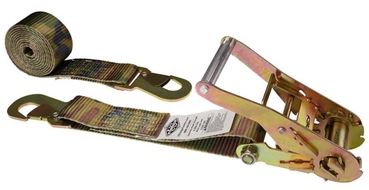
How to Inspect, Clean, and Store Tie Down Straps
With winter weather pretty much over (we hope!), it’s a good time to clean and inspect your tie down straps for wear and tear. Whether you use 1" ratchet straps to tie down a motorcycle in an enclosed trailer, or you’re a flatbed truck driver using 4" winch straps, it’s important to regularly inspect straps, clean them, and store properly when not in use.
Not only will these best practices extend the working life of the strap, they can also be the difference between a safe trip and a disastrous haul.
Inspecting a Tie Down Strap
Besides holes, tears, and knots, check for these sometimes less-obvious indications of wear:
- Broken stitching in the stitch patterns
- Weld splatter, or any areas of melting or charring
- Damage caused from UV rays: color looks bleached or webbing feels stiff
- Small particles embedded in the webbing
- Burnt areas caused by acid, alkali, or other chemicals
- Cracks, pits, or corrosion on ratchets, cam buckles, hooks, and other fittings.
- Unusual wear patterns of webbing at the point of contact with the fitting
- Tag: work load limit information must be visible
Remove the strap from service if you notice any of the indications listed above during inspection. If in doubt, then check The Web Sling and Tie Down Association (WSTDA) publication Recommended Standard Specification for Synthetic Web Tie Downs. It’s the gold standard for tie down maintenance guidelines.
After a thorough inspection, create a record with dates to keep on file. Write your notes in a notebook, or keep an electronic file on your computer; either way, it’s a good idea to also take photos of straps so you can refer to them if needed during the next inspection.
How often should you inspect tie down straps? The WSTDA suggests an initial inspection before bringing the strap back into service. Do this once more each time before using the strap. Periodic inspections should be based on: how often the straps are used and the severity of the conditions the strap is used in. You can also use your experience of using tie downs in similar applications to know how often a strap should be inspected.
How to Clean Tie Down Straps
Keeping straps clean is one of the best ways to extend their working life. Mix a mild detergent with warm water and scrub with a quality scrub brush to loosen any dirt and debris. Avoid bleach-based cleansers or any with acid additives. Even though the polyester fabrication of tie down strap webbing limits water absorption, it’s still best practice to hang straps to allow for thorough air drying.
Tie Down Strap Storage
Hang your straps on walls, store them in plastic bags or fabric bags, etc. However, a good rule of thumb is to be sure and keep them in a dry area away from sunlight.
Learn more from our comprehensive guide to ratchet straps.
More Articles You May Like:
How Many Tie Down Straps Do I Need to Secure My Cargo?
How to Tie Down an ATV Using Ratchet Straps
Tie Down Strap Tag Information: Breaking Strength and Working Load Limits
Wear Sleeves for Tie Down Straps
What Are Ratchet Straps Made Of?







